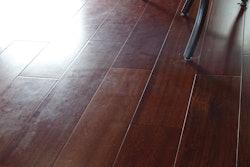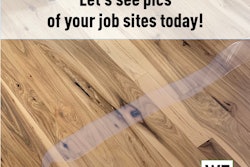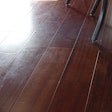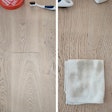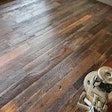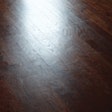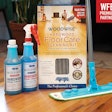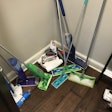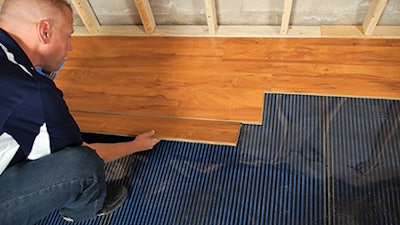
Hardwax Oil Maintenance
What does long-term maintenance look like for flooring with hardwax oil finish?
Nolan Luke, technical manufacturer rep specializing in hardwax oil floors for Regal Hardwoods Inc., answers:
Using hardwax oil on wood has been a European tradition since the 19th century. Improved by 21st century technology, hardwax oil floors can protect a wood floor for hundreds of years. What happens to your customers' floors, however, is determined by their maintenance habits.
Always follow the recommendations from the manufacturer of your specific finish, but in general, I recommend refreshing the hardwax oil finish in accordance with the daily wear on the floor. If there is low risk of having spills or dirt tracked on the floor, I would add a thin coat of refresher oil after the first cleaning and twice a year after that. If heavy wear is predicted, then I would add a coat four times a year. Besides refreshing the hardwax oil coating a few times a year, based on traffic and wear, the long-term maintenance should not vary much from the routine cleaning and dust-mopping.
For routine cleaning, I recommend mopping the floors with a rejuvenating soap—consumers must use cleaning products recommended by the manufacturer, not those you would use on most wood floors. Alcohol-based products will dissolve hardwax oil finish. Also, homeowners should close drapes and blinds where excessive sunlight hits the floor, as that can cause the finish to become sticky.
In the event of stubborn stains, customers should lightly dampen a soft cloth with a manufacturer-recommended hardwood floor cleaner, allow the cleaner to sit on top for about 30 seconds, then lightly agitate and remove the stain. They should apply it directly to the trouble spot and repeat as necessary. If the stain persists, I recommend they contact a wood floor expert or the store where they purchased the flooring. In the event of a deep gouge or scrape, the color of the affected floor board(s) can be repaired by a professional expert without a need to replace the board in question.
RELATED: Wood Floor Finish 101: The Low-Down on Today's Finishes
Electric Radiant & Wood
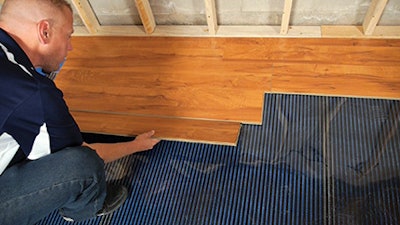
Will the heat from an in-floor electric radiant heat system damage finished wood flooring?
Jack Boesch, director of marketing at MP Global Products, answers:
Not if you select carefully. But keep in mind that flooring products best suited for radiant heat systems are those with greater dimensional stability, including engineered flooring, solid flooring with species known for dimensional stability, quartersawn and riftsawn cuts and narrower widths.
When you're installing wood flooring over this type of radiant heat, look for a system that provides gentle, uniform heat and will not heat the wood floor to a temperature above 85 degrees Fahrenheit. Assuming 85 percent surface coverage (typically the amount of surface heat coverage to aim for), a system that does not raise the temperature of the floor over 85 degrees will conform to most warranties of finished wood flooring. Not all in-floor electric radiant heat systems are engineered that way—some can heat the floor up to 130 degrees and should not be used under any type of wood flooring.
For extra peace of mind, check with the manufacturer of the finished flooring being installed to make sure their flooring is suitable for pairing with in-floor electric radiant heat.
Being OSHA-Aware
Which safety equipment is required by OSHA on a wood flooring job site?
Rusty Swindoll, technical services manager at the National Wood Flooring Association, answers:
OSHA can fine you for all kinds of safety violations on your jobs, and those fines can quickly run into the thousands of dollars. There isn't enough space here to list all possible violations, of course, but there are some obvious and common violations.
One of these is electrical hookup. Use good judgment and keep all your electrical cords in good shape. You can be cited for each worn spot that exposes the wires on your cords. Dangerous practices such as grinding off the ground on a plug are obvious violations. A huge potential violation happens when contractors hook up their 220 power by going right to the electrical panel. In many areas, it is illegal to hook up that way; you must include the cost of an electrician to do so or figure out another source for your 220 power (see the article "Power Up" from the June/July 2008 issue of HF).
Speaking of power, your saws represent another potential fine. Not having the guards in place on your saws, from your chop saw to your table saw, could be grounds for a fine. All relevant safety equipment, from ear protection to eye protection, must be used. When using stain or finish, you need the recommended respirator on the MSDS.
The most important reason to use safety equipment, however, is your health and the health of your workers. It doesn't take much time around older wood flooring contractors to realize your body should not be taken for granted. I am sure if I had used knee pads when I was a contractor instead of thinking I was invincible, I would not have had both knees replaced. Fortunately, many contractors today have a much better attitude about their own health.















